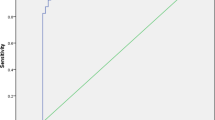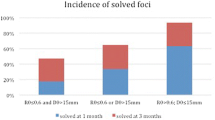Abstract
Objectives
To evaluate the performance of diffusion-weighted imaging (DWI) against the reference standard of gadolinium-enhanced T1-weighted imaging (Gd-T1-WI) in children.
Methods
Thirty-nine consecutive patients (mean age 5.7 years) with suspected acute pyelonephritis underwent magnetic resonance imaging (MRI) including DWI and (the reference standard) Gd-T1-WI. Each study was read in double-blinded fashion by two radiologists. Each kidney was graded as normal or abnormal. Sensitivity and specificity of DWI were computed. Agreement between sequences and interobserver reproducibility were calculated (Cohen κ statistic and the McNemar tests).
Results
Thirty-two kidneys (41 %) had hypo-enhancing areas on Gd-T1-W images. The sensitivity and specificity of DWI were 100 % (32/32) and 93.5 % (43/46). DWI demonstrated excellent agreement (κ = 0.92,) with Gd-T1-W, with no significant difference (P = 0.25) in detection of abnormal lesions. Interobserver reproducibility was excellent with DWI (κ = 0.79).
Conclusion
DWI enabled similar detection of abnormal areas to Gd-T1-WI and may provide an injection-free means of evaluation of acute pyelonephritis.
Key points
• Diffusion weighted magnetic resonance imaging (DWI) can confirm acute pyelonepritis.
• DWI provided comparable results to gadolinium enhanced T1-W MRI in acute pyelonepritis.
• Contrast medium injection could be avoided for diagnosing acute pyelonephritis by MRI.
• MRI with T2-WI and DWI provide a fast and comprehensive diagnostic tool.



Similar content being viewed by others
References
Roberts KB (2011) Urinary tract infection: clinical practice guideline for the diagnosis and management of the initial UTI in febrile infants and children 2 to 24 months. Pediatrics 128:595–610
Preda I, Jodal U, Sixt R, Stokland E, Hansson S (2010) Value of ultrasound in evaluation of infants with first urinary tract infection. J Urol 183:1984–1988
Grattan-Smith JD, Little SB, Jones RA (2008) Evaluation of reflux nephropathy, pyelonephritis and renal dysplasia. Pediatr Radiol 38:S83–S105
Lonergan GJ, Pennington DJ, Morrison JC, Haws RM, Grimley MS, Kao TC (1998) Childhood pyelonephritis: comparison of gadolinium-enhanced MR imaging and renal cortical scintigraphy for diagnosis. Radiology 207:377–384
Majd M, Nussbaum Blask AR, Markle BM et al (2001) Acute pyelonephritis: comparison of diagnosis with 99mTc-DMSA, SPECT, spiral CT, MR imaging, and power Doppler US in an experimental pig model. Radiology 218:101–108
Riccabona M, Avni FE, Blickman JG et al (2008) Imaging recommendations in paediatric uroradiology: minutes of the ESPR workgroup session on urinary tract infection, fetal hydronephrosis, urinary tract ultrasonography and voiding cystourethrography, Barcelona, Spain, June 2007. Pediatr Radiol 38:138–145
Fukuda Y, Ohashi I, Hanafusa K et al (2000) Anisotropic diffusion in kidney: apparent diffusion coefficient measurements for clinical use. J Magn Reson Imaging 11:156–160
Toyoshima S, Noguchi K, Seto H, Shimizu M, Watanabe N (2000) Functional evaluation of hydronephrosis by diffusion-weighted MR imaging. Relationship between apparent diffusion coefficient and split glomerular filtration rate. Acta Radiol 41:642–646
Verswijvel G, Vandecaveye V, Gelin G et al (2002) Diffusion-weighted MR imaging in the evaluation of renal infection: preliminary results. JBR-BTR 85:100–103
Taouli B, Sandberg A, Stemmer A et al (2009) Diffusion-weighted imaging of the liver: comparison of navigator triggered and breathhold acquisitions. J Magn Reson Imaging 30:561–568
Chan JH, Tsui EY, Luk SH et al (2001) MR diffusion-weighted imaging of kidney: differentiation between hydronephrosis and pyonephrosis. Clin Imaging 25:110–113
Leeuwenburgh MM, Wiarda BM, Bipat S et al (2012) Acute appendicitis on abdominal MR images: training readers to improve diagnostic accuracy. Radiology 264:455–463
Thoeny HC, De Keyzer F (2011) Diffusion-weighted MR imaging of native and transplanted kidneys. Radiology 259:25–38
Thoeny HC, De Keyzer F, Oyen RH, Peeters RR (2005) Diffusion-weighted MR imaging of kidneys in healthy volunteers and patients with parenchymal diseases: initial experience. Radiology 235:911–917
Martina MC, Campanino PP, Caraffo F et al (2010) Dynamic magnetic resonance imaging in acute pyelonephritis. Radiol Med 115:287–300
Stunell H, Buckley O, Feeney J, Geoghegan T, Browne RF, Torreggiani WC (2007) Imaging of acute pyelonephritis in the adult. Eur Radiol 17:1820–1828
Kavanagh EC, Ryan S, Awan A, McCourbrey S, O’Connor R, Donoghue V (2005) Can MRI replace DMSA in the detection of renal parenchymal defects in children with urinary tract infections? Pediatr Radiol 35:275–281
Kovanlikaya A, Okkay N, Cakmakci H, Ozdogan O, Degirmenci B, Kavukcu S (2004) Comparison of MRI and renal cortical scintigraphy findings in childhood acute pyelonephritis: preliminary experience. Eur J Radiol 49:76–80
Smith T, Evans K, Lythgoe MF, Anderson PJ, Gordon I (1996) Radiation dosimetry of technetium-99m-DMSA in children. J Nucl Med 37:1336–1342
Vestergren E, Jacobsson L, Lind A, Sixt R, Mattsson S (1998) Administered activity of 99Tcm-DMSA for kidney scintigraphy in children. Nucl Med Commun 19:695–701
Jones RA, Grattan-Smith JD (2003) Age dependence of the renal apparent diffusion coefficient in children. Pediatr Radiol 33:850–854
Rohrschneider WK, Haufe S, Wiesel M et al (2002) Functional and morphologic evaluation of congenital urinary tract dilatation by using combined static-dynamic MR urography: findings in kidneys with a single collecting system. Radiology 224:683–694
Vivier PH, Storey P, Rusinek H et al (2011) Kidney function: glomerular filtration rate measurement with MR renography in patients with cirrhosis. Radiology 259:462–470
Author information
Authors and Affiliations
Corresponding author
Rights and permissions
About this article
Cite this article
Vivier, PH., Sallem, A., Beurdeley, M. et al. MRI and suspected acute pyelonephritis in children: comparison of diffusion-weighted imaging with gadolinium-enhanced T1-weighted imaging. Eur Radiol 24, 19–25 (2014). https://doi.org/10.1007/s00330-013-2971-2
Received:
Revised:
Accepted:
Published:
Issue Date:
DOI: https://doi.org/10.1007/s00330-013-2971-2




